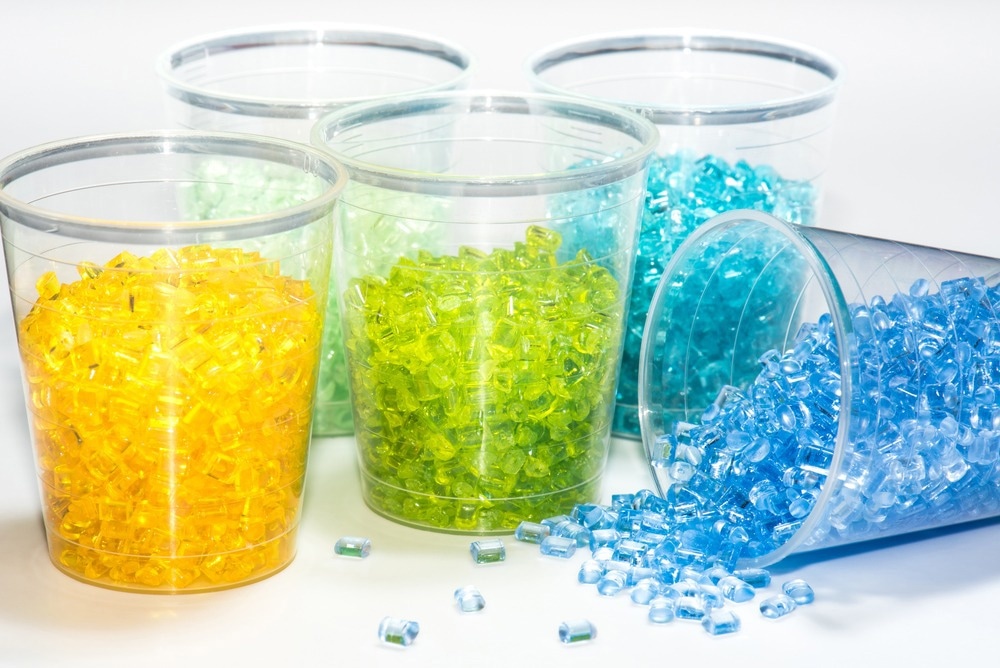Macromolecules make up the majority of plastics, which are then processed into shaped pieces, semi-finished goods, films, or fibers. The selection of macromolecules, the production method, and the incorporation of so-called additives can change how technical properties like hardness and elasticity are expressed. Thermoplastics and thermosets are two major kinds of polymers that are frequently used in plastic injection molding to produce many common everyday items. The article provides technical information about thermoplastics and thermosetting polymers while mentioning the major differences between the two types.

Image Credit: XXLPhoto/Shutterstock.com
A Brief Overview of Thermoplastics
Owing to their linear or branched chains, thermoplastics are polymers that can be repeatedly dissolved and reshaped. Weak intermolecular forces permit the chains to move readily, giving them the ability to soften and dissolve at elevated temperatures. These substances can be distorted by heating within a particular temperature range. As long as no thermal breakdown of the substance occurs, the entire procedure is reversible and can be replicated as often as needed by cooling and reheating.
Thermoplastics are typically resilient to acids, alkalis, solvents, and lubricants. This renders them suitable for tasks subjected to severe chemical forces. The excellent electrical and thermally insulating attributes of thermoplastics make them ideal for the production of electronic devices and cables. Another beneficial characteristic of thermoplastics is their weldability, which enables them to be welded by heating them until they are flexible and malleable and then pressing the joined parts together.
What are Thermosetting Polymers?
Thermosets, also known as duromers or thermosetting plastics, exhibit a unique characteristic of retaining their form and shape once they undergo curing. This distinctive behavior is attributed to the spatial cross-linking of their polymers, rendering them insoluble. The remarkable mechanical and chemical resistance displayed by thermosets, particularly at elevated temperatures, makes them highly suitable for a wide range of applications, including electrical installations.
The bonds inhibit the polymeric strands from melting or softening by limiting their motion. Robust covalent bonds produce the crosslinks that give thermosetting polymers sturdiness and resilience. High strength and stiffness are only a couple of the remarkable mechanical qualities that thermosetting polymers possess. In thermosetting polymeric compounds, crosslinks offer heat resilience and chemical resistance.
Processing Methods of Thermoplastics vs. Thermosetting Polymers
The solid polymer is transformed during treatment into a desired size and shape. The polymer can be shaped using a variety of techniques, such as rotational molding, injection molding, and extrusion.
PVC pipes, profiled PVC window moldings, and sheets made of various polymers are all produced using extruders, which continually manufacture rods or sheets.
Injection molding is a technique used in the production of polymers. With this method, you have a largely unrestricted choice of form and surface texture, including patterns, particles, and smooth finishes. The thermoplastic material is plasticized or liquefied by the machine throughout injection molding, and then it is injected under pressure into a mold.
Typically, thermoset materials are manufactured via liquid molding techniques. The polymers, along with additional substances, are introduced into heated containers or casks, where they are combined and liquefied. The liquid polymers and additional agents are subsequently poured into a mold chamber. As the substance cools down and hardens to conform to the shape of the cavity, it undergoes a curing process in which the polymers cross-link.
Reaction Injection Molding (RIM) and Resin Transfer Molding (RTM) are the two most common liquid molding procedures utilized to produce thermoset plastics. Thermoplastic fabrication techniques are more adaptable for generating complicated shapes, whereas thermosetting polymer manufacturing techniques are better adapted for producing unyielding structures.
Comparison of Thermal Properties of Thermoplastics vs. Thermosetting Polymers
The solidifying and glass transition temperatures of thermoplastics influence their manufacturing and implementation.
Although thermoplastic materials can be deformed by heat, their heat resistance and thermal stability vary.
To begin and wrap up the crosslinking procedure, thermosetting polymers require particular curing temperatures and timeframes. As a result of their cross-linked structure, they have exceptional thermal resistance and combustion retardancy.
A Brief Comparison of Tensile Characteristics
Thermoplastics typically exhibit high ductility and strength. They are capable of continuous bending without suffering irreversible damage. Their relatively low crosslinking density permits elasticity and energy absorption during mechanical loads. In contrast to thermosetting polymers, thermoplastic materials may exhibit lower thermal resistance and stability in dimension.
The cross-linked framework of thermosetting polymers, in contrast, affords exceptional structural rigidity and resistance to heat and creep displacement. These polymers demonstrate exceptional stiffness and strength once they have cured, which renders them suitable for applications where sturdiness and stabilization are crucial. Nevertheless, thermosetting polymers are typically less resilient than thermoplastics, and their inability to endure plastic deformation limits their robustness and ductility.
In short, both thermoplastics and thermosetting polymers have advantageous properties, and the selection is dependent on operating conditions, temperature, and mechanical requirements.
More from AZoM: How are Bioplastics Made?
References and Further Reading
Bufa Thermoplastic Composites, 2023. How are Thermoplastic Composites Processed?. [Online]
Available at: https://thermoplasticcomposites.de/en/processing-2/
BUFA Thermoplastic Composites, 2023. What are the differences between thermoplastics, thermosets & elastomers?. [Online]
Available at: https://thermoplasticcomposites.de/en/2023/01/23/the-world-of-plastics/
H., 2022. Difference Between Thermoplastics and Thermosetting Plastics. [Online]
Available at: https://www.theengineeringknowledge.com/difference-between-thermoplastics-and-thermosetting-plastics/
Harper, C. A., 2002. Handbook of Plastics, Elastomers, and Composites. Fourth ed. Maryland: McGraw-Hill.
O., 2023. Thermoplastics vs. Thermosetting. [Online]
Available at: https://diffzi.com/thermoplastics-vs-thermosetting/
Osborne , 2018. How Thermoset Plastics Are Made & Manufactured?. [Online]
Available at: https://www.osborneindustries.com/news/how-thermoset-plastics-are-manufactured/
Disclaimer: The views expressed here are those of the author expressed in their private capacity and do not necessarily represent the views of AZoM.com Limited T/A AZoNetwork the owner and operator of this website. This disclaimer forms part of the Terms and conditions of use of this website.